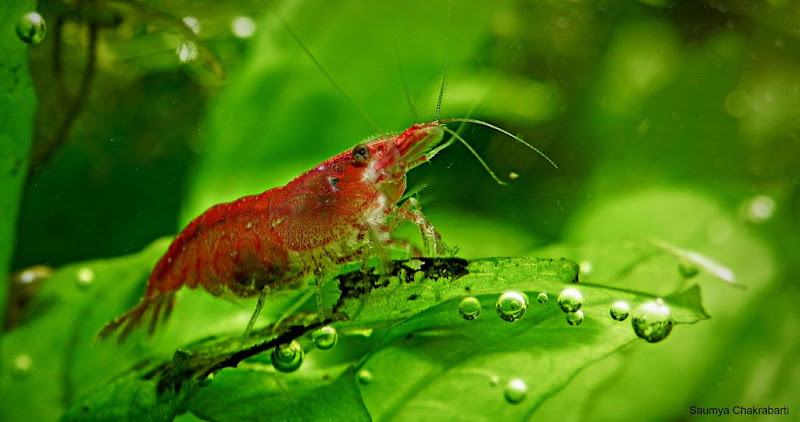When people think about Aquariums, most only picture the different types of fish available. But fish aren’t the only aquatic life that is available. If you're bored of fish, or want something other than fish in your aquarium that requires less maintenance, shrimp are a great option. Aquarists have discovered that freshwater aquarium shrimp can match the beauty of freshwater aquarium fish and extremely rewarding.
There is just as much variety in the types of shrimp you can keep as the types of fish available. They come in all sizes and colors, range from very easy to keep to quite difficult, and are both easy to breed and nearly impossible in a freshwater aquarium. However, there are a few important things to consider when thinking about adding shrimp in general to an aquarium.

Chrystal Red Shrimp Picture
First, you must consider your existing tankmates (should you have any). In caring for "freshwater aquarium shrimp", it must be considered that with their size, isolating them would be a good idea. They must be kept in a separate tank because small shrimp are at risk of being eaten by freshwater fish. This makes them tasty snacks for larger fish. If you have any large fish, like Oscars fish or other cichlids, you may want to avoid wasting your money. Also, certain fish eat shrimp in the wild and will quickly consume any you may buy for your aquarium.
These shrimp eating fish include loaches, puffers, and some gouramis. Mixing shrimp with fish is also not always a good investment due to the fact that if you buy a type of shrimp that does breed easily, baby shrimp will most likely be quickly snapped up. Therefore, your population will not replenish itself and the larger shrimp will die of old age.

Amano Shrimp Picture
Second, the aquarium is filled with hazards for shrimp that don't exist in the wild, namely filter intakes. Most are shielded somewhat, and this does the job for most adult shrimp unless the filter is particularly strong. However, baby shrimp will be sucked into the filter and, depending upon what type of filter you have, either lead very boring lives stuck in a canister filter or be smashed to death in the impeller. To prevent this, you can either put a piece of stocking over the end of the intake and secure it with a rubber band or plastic tie; cut a hole in a sponge like the types you buy for filter media and stick this over the intake, or switch to air-driven sponge filters. The stocking and sponge options will quickly clog with debris and need to be taken out and cleaned every week or two, so they are quite intensive. The sponge on the other hand is guaranteed not to bubble anything to death, but it will disperse CO2 if you are using it in your aquarium, and they tend to be quite large and ugly (not to mention take up valuable space inside the aquarium).

Blue Tiger Shrimp Photo
Third, make sure the type of shrimp you want matches your aquarium. Neocaridina japonica, or Amano shrimp, grow to be up to 2 inches long and eat algae, but the eggs will not hatch in freshwater. These are best suited for aquariums with fish. Crystal red shrimp can be upwards of $50 per shrimp for a good pattern and are very sensitive to water conditions, but will breed quickly if conditions are right. You wouldn't want to put those in with fish unless you like to give your fish very expensive snacks. Do a little research on the type of shrimp you are interested in and make sure it works with your current or planned setup.

Pregnant Cherry Shrimp Photo
Finally, shrimp should only be put in a mature tank as they are very sensitive to ammonia and nitrates. They are much more picky about water parameters. Aquarist have found that adding certain fertilizers containing trace elements will kill off Cherry shrimp, but not the Amano shrimp (most likely due to the copper or other heavy metals in the fertilizer). A tank should not be medicated when shrimp are in it. They are often much more sensitive to medications than fish: copper being the most lethal. Even foods should be examined to make sure they do not contain copper.
Overall, shrimp are an excellent addition to an aquarium and slowly has gained its market growth and look becomes an old practice rediscovered as a hobby. In fact, many people and aquarist keep tanks of just shrimp today. As a hobby, freshwater aquarium shrimp are not time consuming and give the same joy the fish.

